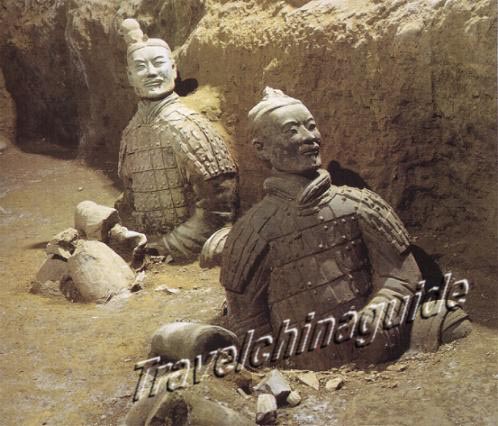Terra Cotta Warriors
- Terra Cotta Warriors were first discovered May 1974 by an Archaeology team.
- Qin Shi Huang Di- China’s first emperor
- At the age of 13, started the construction of his tomb
- He wanted his army to be with him after he died and to be buried with him and protect him even in his afterlife.
Discovery of the Tomb
-
Found broken pieces of pottery figurines and bronze arrowheads,
while digging a well in a small village in eastern
-
Archaeologist- Yuan Zhongyi launched
an excavation/investigation in May 1974 and is not the director of the Terra
Cotta Museum in
- The pieces that were discovered were later determined to be located at the southeast corner of the 1st trench or pit of the tombs.
1st Trench
- Discovered 1974- largest trench at over 20,000 square meters; over 7000 terra cotta horses and armored warriors in strategic formation. Column after column of soldiers at the front and war chariots in the back poised for battle.
2nd Trench
- Discovered May 1976- 6,000 square meters shaped like a carpenters square; deployment of statues reflects Sun Zi’s war strategy which they used to defeat the state of Zhao.
3rd Trench
- Smallest trench 520 square meters; thought to be the headquarters or command center of the troops. There was no battle array and there were animal bones and deer skin most likely offered as sacrifices on the eve of battle. Bronze weapons also.
4th Trench- a fourth later discovered, but was empty most likely because of uprisings
that prevented from being completed.
Statues
- height of warriors aprox. 5’8”-6’1”; combination molding sculpting techniques used. Baked at temperatures between 950-1059 degrees Celsius for as long as up to 3 days.
- Vividly different features and expressions from posing of different people as models. No two figures were found to have same features.
Statue Types- general, junior officer, robed infantrymen, light infantry archer, armorclad infantryman, lower echelon soldier, staff officer, kneeling archers, charioteer, horses.
Paint- figures painted with ancient pigments made from minerals mixed with a binder such as animal blood or egg white. Charcoal used to tint hair. Yellow, red, green, blue, white, black.
- great attention to detail of face, particularly the eye.
- Point of studying statues: offers practical data/info. Concerning types of armed units, battle arrays/formations, weapons distribution, strategic tactical thinking.

The trenches

